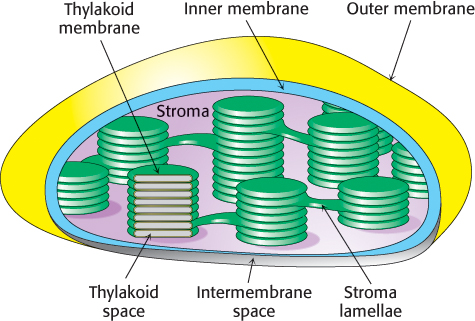19.1Photosynthesis Takes Place in Chloroplasts
Photosynthesis Takes Place in Chloroplasts

Photosynthesis, the means of converting light into chemical energy, takes place in organelles called chloroplasts, typically 5 μm long. Like a mitochondrion, a chloroplast has an outer membrane and an inner membrane, with an intervening intermembrane space (Figure 19.2). The inner membrane surrounds a space called the stroma, which is the site of the dark reactions of photosynthesis (Section 20.1). In the stroma are membranous structures called thylakoids, which are flattened sacs, or discs. The thylakoid sacs are stacked to form a granum. Different grana are linked by regions of thylakoid membrane called stroma lamellae (Figure 19.3). The thylakoid membranes separate the thylakoid space from the stroma space. Thus, chloroplasts have three different membranes (outer, inner, and thylakoid membranes) and three separate spaces (intermembrane, stroma, and thylakoid spaces). In developing chloroplasts, thylakoids arise from budding of the inner membrane, and so they are analogous to the mitochondrial cristae. Like the mitochondrial cristae, they are the site of coupled oxidation–

The primary events of photosynthesis take place in thylakoid membranes
The thylakoid membranes contain the energy-
568
Chloroplasts arose from an endosymbiotic event

 Chloroplasts contain their own DNA and the machinery for replicating and expressing it. However, chloroplasts are not autonomous: they also contain many proteins encoded by nuclear DNA. How did the intriguing relation between the cell and its chloroplasts develop? We now believe that, in a manner analogous to the evolution of mitochondria (Section 18.1), chloroplasts are the result of endosymbiotic events in which a photosynthetic microorganism, most likely an ancestor of a cyanobacterium (Figure 19.4), was engulfed by a eukaryotic host. Evidence suggests that chloroplasts in higher plants and green algae are derived from a single endosymbiotic event, whereas those in red and brown algae are derived from at least one additional event.
Chloroplasts contain their own DNA and the machinery for replicating and expressing it. However, chloroplasts are not autonomous: they also contain many proteins encoded by nuclear DNA. How did the intriguing relation between the cell and its chloroplasts develop? We now believe that, in a manner analogous to the evolution of mitochondria (Section 18.1), chloroplasts are the result of endosymbiotic events in which a photosynthetic microorganism, most likely an ancestor of a cyanobacterium (Figure 19.4), was engulfed by a eukaryotic host. Evidence suggests that chloroplasts in higher plants and green algae are derived from a single endosymbiotic event, whereas those in red and brown algae are derived from at least one additional event.
The chloroplast genome is smaller than that of a cyanobacterium, but the two genomes have key features in common. Both are circular and have a single start site for DNA replication, and the genes of both are arranged in operons—